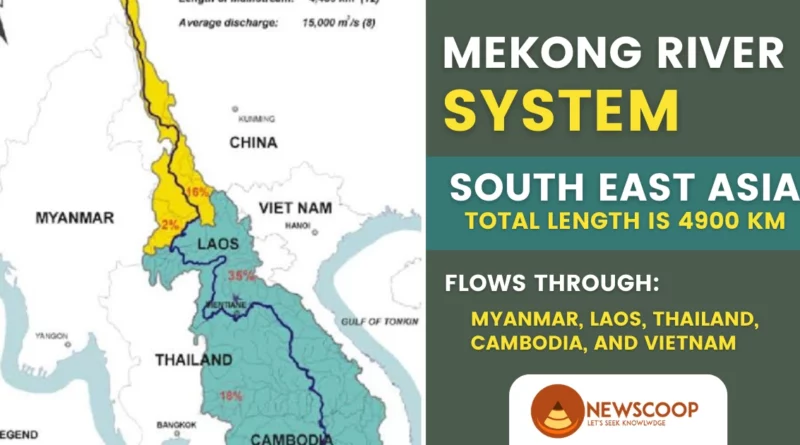Mekong River System: Map | Tributaries & Dams
The Mekong River is one of the largest and most important rivers in Southeast Asia. It is approximately 4,900 kilometers long and flows through six countries: China, Myanmar, Laos, Thailand, Cambodia, and Vietnam. The river is a vital source of water and food for millions of people in the region, as well as a key transportation route for goods and people.
In this article, we will explore the Mekong River (Dams, Tributaries & maps)and its significance, as well as some of the unique features and attractions that can be found along its banks.
| River | Mekong River |
| Origin | Tibetan Plateau of China |
| Mouth | South China Sea |
| Area cover | 795,000 km sq. |
| Total Length | 4900 km |
| Flows through | Myanmar, Laos, Thailand, Cambodia, and Vietnam |
| Dams | China’s Dams, Xayaburi Dam, Don Sahong Dam, Lower Sesan 2 Dam |
| Major Tributaries | Nam Ta, Nam Ou, Nam Soung, Nam Khan, and Nam Mae Ing |
Geography of the Mekong River
The Mekong River originates in the Tibetan Plateau of China and flows southward through Myanmar, Laos, Thailand, Cambodia, and Vietnam before emptying into the South China Sea. The river and its tributaries form an extensive network of waterways, covering an area of approximately 795,000 square kilometers.
The Mekong River Basin is home to some of the world’s most diverse ecosystems, including tropical rainforests, wetlands, and freshwater fisheries. The basin is also a biodiversity hotspot, with over 20,000 plant species, 1,200 fish species, and numerous bird and mammal species.
Dams on the Mekong River
The Mekong River is home to several large dams, which have had a significant impact on the river and the people who depend on it for their livelihoods. Here are some of the major dams on the Mekong River:
1. China’s Dams
- China has built several dams on the upper reaches of the Mekong River, including the Manwan, Dachaoshan, and Jinghong dams.
- These dams have significantly reduced the flow of water downstream, affecting fishing and agriculture in Laos, Thailand, Cambodia, and Vietnam.
2. Xayaburi Dam
- The Xayaburi Dam is located in northern Laos and is one of the largest dams on the Mekong River.
- It is designed to generate electricity for export to Thailand and other countries in the region.
- The dam has been controversial due to its potential impact on fisheries and river ecosystems downstream.
3. Don Sahong Dam
- The Don Sahong Dam is located in southern Laos and is designed to generate electricity for export to Cambodia and Vietnam.
- The dam has been criticized for its potential impact on fish migration and the livelihoods of local communities.
4. Lower Sesan 2 Dam
- The Lower Sesan 2 Dam is located in northeastern Cambodia and is designed to generate electricity for export to Vietnam.
- The dam has been criticized for its potential impact on fish migration and the livelihoods of local communities, including the displacement of thousands of people.
Impact of Dams on the Mekong River
The construction of dams on the Mekong River has had a significant impact on the river and the people who depend on it for their livelihoods. Here are some of the main impacts:
- Reduced Fish Stocks: Dams on the Mekong River have significantly reduced fish stocks downstream, affecting the livelihoods of millions of people who depend on fishing for their income and food security.
- Altered River Ecosystems: Dams have altered the natural flow of the river, which has affected river ecosystems and the species that depend on them. For example, fish migration patterns have been disrupted, and water quality has been affected.
- Displacement of Communities: The construction of dams has resulted in the displacement of thousands of people who live along the river. These communities have often been forced to relocate and have lost access to traditional fishing and agricultural practices.
- Increased Risk of Flooding: Dams can increase the risk of flooding downstream by altering the natural flow of the river. This can have devastating consequences for communities living along the river.
Tributaries of the Mekong River for UPSC
The River, which runs through China, Myanmar, Laos, Thailand, Cambodia, and Vietnam, has numerous tributaries on both its left and right banks. These tributaries contribute to the Mekong’s overall water flow, support aquatic ecosystems, and sustain local communities. Here are some of the major left and right bank tributaries of the Mekong River:
| Left Bank Tributaries | Right Bank Tributaries |
|---|---|
| Nam Ou River | Tonle Sap River |
| Nam Tha River | Mun River |
| Se Bang Fai River | Sesan River |
Left Bank Tributaries
- Nam Ou River: The Nam Ou River is a major tributary of the Mekong River, located on the left bank in northern Laos. The river flows for 448 kilometers through Laos and into the Mekong near Luang Prabang.
- Nam Tha River: The Nam Tha River is the largest tributary of the Mekong River in Laos, also located on the left bank. The river flows for over 400 kilometers from its headwaters in northern Laos before joining the Mekong River near Luang Prabang.
- Se Bang Fai River: The Se Bang Fai River is a left-bank tributary of the Mekong River located in southern Laos. It is approximately 135 kilometers long and flows into the Mekong River near the city of Pakse.
Right Bank Tributaries
- Tonle Sap River: The Tonle Sap River is a major tributary of the Mekong River located on the right bank in Cambodia. It originates at the Tonle Sap lake and flows for 120 kilometers before joining the Mekong River in Phnom Penh.
- Mun River: The Mun River is one of the largest right-bank tributaries of the Mekong River, located in northeastern Thailand. It flows for over 700 kilometers from its headwaters in the Khao Yai National Park before joining the Mekong River in southern Laos.
- Sesan River: The Sesan River is a right-bank tributary of the Mekong River, located in northeastern Cambodia. It is approximately 260 kilometers long and flows into the Mekong River near the border with Vietnam.
Overall, the tributaries of the Mekong River are crucial to the health of the river and the communities that depend on it. They provide essential freshwater resources and support aquatic biodiversity.
Importance of the Mekong River
The Mekong River is an essential source of livelihood for millions of people in the region. It provides water for irrigation, drinking, and fishing, as well as a means of transportation for people and goods. The river also plays a crucial role in the economy of the region, with many industries such as agriculture, fisheries, and tourism dependent on its resources.
Unique Features and Attractions
The Mekong River offers a variety of unique features and attractions for visitors to explore. Here are some of the highlights:
- The Mekong Delta: Located in southern Vietnam, the Mekong Delta is a vast network of waterways, islands, and floating markets. Visitors can explore the delta by boat, visit local villages, and try traditional Vietnamese cuisine.
- Luang Prabang: Located in northern Laos, Luang Prabang is a UNESCO World Heritage site known for its Buddhist temples, colonial architecture, and vibrant night markets. Visitors can also take a boat trip on the Mekong River to visit the Pak Ou Caves, which are filled with thousands of Buddha statues.
- Angkor Wat: Located in Siem Reap, Cambodia, Angkor Wat is a UNESCO World Heritage site and one of the most significant archaeological sites in Southeast Asia. Visitors can explore the ancient temples and ruins of the Khmer Empire, dating back to the 9th century.
- Golden Triangle: Located at the intersection of Thailand, Laos, and Myanmar, the Golden Triangle is known for its opium trade and remote hill tribe villages. Visitors can take a boat trip on the Mekong River and explore the local culture and history.
Conclusion
The Mekong River is a vital and fascinating part of Southeast Asia, with a rich history, diverse ecosystems, and unique cultural attractions. Whether you are interested in exploring ancient ruins, trying traditional cuisine, or simply taking in the natural beauty of the river, there is something for everyone along the banks of the Mekong.
Thank You!
How many countries does the Mekong River flow through?
The Mekong River flows through six countries: China, Myanmar, Laos, Thailand, Cambodia, and Vietnam.
How long is the Mekong River?
The Mekong River is approximately 4,900 km long, making it the seventh longest river in Asia.
Where is the source of the Mekong River?
The source of the Mekong River is in the Tibetan Plateau, at an altitude of over 5,000 meters.
Related Links:

